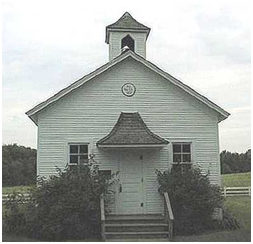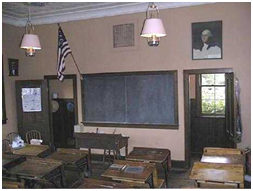

School Children in 1914
Presented by Ana "Rose" Lyles-Riebli
My name is Rose and this is Mrs. Mayer. We are celebrating the centennial year of Ephrata High School. That means that Ephrata High School is 100 years old and there is going to be a big party! As part of the celebration we are going to share with you what it was like to be a pioneer school child 100 years ago in the year 1914. We are especially happy to have some pioneer school children with us today.
 Who knows what a pioneer is? A pioneer is a person who ‘goes before’, preparing the way for
others. In the early 1900s most of the pioneers who settled in this area arrived by a
steam-engine train. Where did they come from? They came from other states and foreign
countries. Why did they come? They had heard about the possibilities of this newly-opened
land and wanted to take advantage of the opportunity to build a happy and prosperous life
for their families.
Who knows what a pioneer is? A pioneer is a person who ‘goes before’, preparing the way for
others. In the early 1900s most of the pioneers who settled in this area arrived by a
steam-engine train. Where did they come from? They came from other states and foreign
countries. Why did they come? They had heard about the possibilities of this newly-opened
land and wanted to take advantage of the opportunity to build a happy and prosperous life
for their families.
Let’s talk about how a young pioneer person spent their day. They were up very early and got dressed in a hurry because there were lots of farm chores to do. The boys’ chore was to get the many horses fed and watered so their father could take them to the field to work. After that there were other animals to water and feed: the milk cows, the beef cattle, the hogs, the chickens along with the farm pets, the cats and dogs. The boys milked the cows while the girls gathered eggs.
After the mother served a breakfast of eggs, mush, and bread, which was cooked over a wood-burning stove, it was time for the school-age children to get ready for school. They gathered up their lunch pails and books.
How did they get to school? There were no school busses. They walked. The schoolhouse could be up to two miles away. That means that their walk to school was like walking around a high school football field eight times before they even got to school! And don’t forget, they would have to walk that same distance back in order to return home.
If the children were lucky their family had a horse to ride. All the children in the family would have to take turns riding the horse, or they could all get on together and hold onto each other tight so they wouldn’t fall off. Once they got to school they would take care of their horse and put him in a corral where he would stay until it was time to return home. In bad weather, such as cold, snow, rain, dust or windstorms the pioneer father hitched up the horses and wagon in order to get the children to school safely.
In 1900 most children attended prairie schools because they lived on prairie farms with their families. After the pioneer families had built their homes and planted their fields the next most important thing that they did was to build a school house. The pioneer parents believed that for their children to succeed in this new part of the country they would need a good education and, in some cases, learn to speak English.
The school building had just one room and it had no electricity for lights and no plumbing for running water. All ages of children attended the one-room school house at the same time. The toilets were little outhouses – one for the girls and one for the boys. The school yard would be covered with dirt.
Most likely the teacher would be a young lady who had recently graduated from the 8th grade and had very little further training. Sometimes her students would be bigger that she was. She would live in the home of one of her students and she was not allowed to be married.
 Inside the school house the teacher’s desk was up front and faced rows of desks and benches.
The room had a map of the world on a wall, a large dictionary to check the correct spelling
of words, along with a United States flag. The flag had only 48 stars because there were only
48 states at the time.
Inside the school house the teacher’s desk was up front and faced rows of desks and benches.
The room had a map of the world on a wall, a large dictionary to check the correct spelling
of words, along with a United States flag. The flag had only 48 stars because there were only
48 states at the time.
Once the children got to school ... more chores. They hauled in sagebrush for heating the stove and filled up buckets with water. Some of the water was poured into a small basin which was used for washing hands. A small towel was placed next to it. The bucket of water would have a dipper spoon placed into it and was used for drinking. Everyone used the same water basin and towel and drank from the same dipper – not very sanitary was it?
What a busy day and the school children hadn’t even begun to study! The school day mornings usually began with the recitation of the Pledge of Allegiance. The students then spent the day with reading, writing and arithmetic. They would use small chalkboards to practice arithmetic and pens with ink to practice writing. Because there was a shortage of books they used other ways to learn by memorizing long poems, competing in arithmetic contests, and holding spelling bees.
There is one thing the pioneer school children did have that you also have. Can you guess what? How about recess? Pioneer children liked to have fun when they weren’t busy doing their chores. What do you think they did for fun? Boys played baseball, and with marbles and metal toys. Girls played jump rope, hopscotch, and played with their rag dolls. Andy, Andy Over and tug of war with the girls’ jump ropes were games they played together.
After a busy day at school the children headed home to do their evening chores. The boys helped their mothers by putting the rugs and blankets on a clothes line and beating the dirt out of them with a rug beater. The boys also brought in wood for the cook stove so their mother could cook dinner. If they had time they pulled weeds in the family’s vegetable garden and, if they were old enough, they helped their father with field work.
The girls helped their mother prepare food for the family. They helped bake bread made from the wheat flour that was grown and ground by their father. They would take the cream from the cow’s milk and churn it into butter or on special days turn the cream into ice cream. Sometimes the girls helped mend clothes and sewed together pieces of material to make quilts for their beds.
Both of the boys and girls helped their mother with washing the family’s clothing. The boys would go out to the well in the back yard and pump buckets of water which they would bring into the house and put on the cook stove in order to get the water hot. After the water got hot the boys dumped the buckets of water into the wash tub. That’s when the girls took over – scrubbing the clothes on a wash board and hanging them out to dry. Only the good clothes were ironed.
After dinner the children got busy with their homework. Yes, they also had home work. They studied by the light from a kerosene lamp. Before getting ready for bed they would make a visit to the outhouse. After such a busy day the children were happy to be off to bed so that they could rest up for the next day.
Mrs. Mayer is going to share with you some of the every-day items that schoolchildren used to help make their life more comfortable 100 years ago.
© 2014 - Ephrata Alumni Association
Ephrata High School, 333 4th Avenue NW, Ephrata, Washington 98823